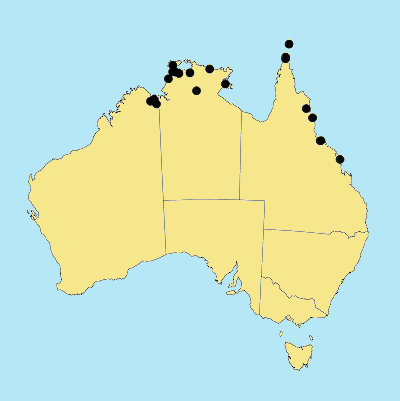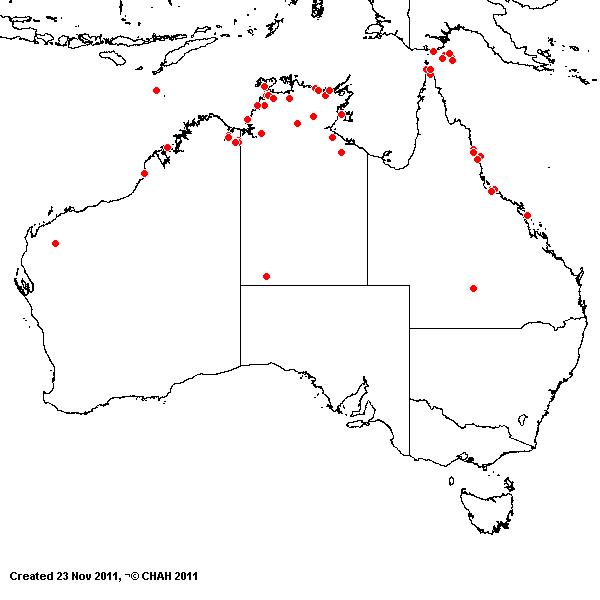Eragrostis tenella* (L.) P. Beauv. ex
Roem. & Schult. . Syst. Veg. 2: 576 (1817).
Classification. (GPWG 2001) : Subfamily Chloridoideae. Cynodonteae.
Basionym and/or
Replacement Name: Poa tenella
L., Sp. Pl.
1: 69 (1753).
Type of Basionym or
Protologue Information: LT: Anonymous, (LINN-87.33). LT designated
by Mitra & Jain in Manilal (ed.), Bot. Hist. Hort. Malab. : 151 (1980);
also superfluously by Veldkamp, Blumea 47(1): 164 (2002).
Recent synonyms:
Eragrostis amabilis (L.) Hook. & Arn.
Key references
(books and floras): [1878] G.Bentham, Flora Australiensis 7 (643),
[1969] E.E.Henty, Manual Grasses New Guinea (96), [2002] D.Sharp
& B.K.Simon, AusGrass, Grasses of Australia (as E. amabilis).
Habit. Annual.
Culms geniculately ascending or decumbent, 6–50 cm tall. Ligule a fringe of
hairs. Leaf-blades 2–9 cm long, 1–3 mm wide.
Inflorescence.
Inflorescence compound, a panicle. Panicle linear (var insularis) or elliptic
or pyramidal, 2–14 cm long.
Spikelets.
Spikelets pedicelled. Fertile spikelets many flowered, with at least 2 fertile
florets (4–8), comprising 4–8 fertile floret(s), with diminished florets at the
apex, ovate or obovate, laterally compressed, 1.5–2.5 mm long.
Glumes. Glumes
similar. Lower glume ovate, keeled, 1-keeled, 1 -nerved. Upper glume ovate,
0.5–1 mm long, keeled, 1-keeled, 1 -nerved.
Florets.
Fertile lemma 0.7–1 mm long, keeled, 3 -nerved. Anthers 3. Grain 0.5 mm long.
Continental
Distribution: Africa, Temperate Asia, Tropical Asia, Australasia, Pacific,
North America, and South America.
Australian Distribution:
Western Australia, Northern
Territory, Queensland, Christmas
Is, Cocos Keeling Is, Ashmore Reef, Coral Sea
Is.
Western
Australia: Gardner.
Northern Territory:
Darwin & Gulf. Queensland:
Cook, North Kennedy, South Kennedy.
Notes. A
troublesome weed.
Distinguishing characters include open
panicle, sometimes pilose in axils of axis; spikelet terminated by vestigial
floret or naked rachilla internode, with jointed rachilla, and loose florets
usually falling entire; glumes subhyaline; lemmas with ribbed submarginal
lateral nerves; palea keels ciliate with elatively long hairs visible in situ;
anthers minute, terminally exserted; caryopsis turgid, shiny, subacute at apex
and base; often leaves pilose, and the orifice, collar and outer margin of
sheaths stiffly hairy; blades thin in texture.
Australian plants belong to the typical
variety. Eragrostis tenella var. insularis C.E.Hubb., from the
shores of the Indian Ocean, is similar in
spikelet morphology, but has a linear or contracted panicle.
Introduced; occurs
near Kununurra and Wyndam, W.A., Darwin area and E, Melville Island and Ashmore
Reef, N.T., the tip of Cape York Penin., Torres Strait Islands and from Cairns
to Mackay, Qld.; native to Africa, SE Asia, world tropics. Weed of gardens,
lawns and roadsides; usually in sandy soils; also in woodland clearings, beach
sands, and in shallow soils over laterite.; flowers Jan.-July, Oct.; fruits
Jan.-July, Oct.



